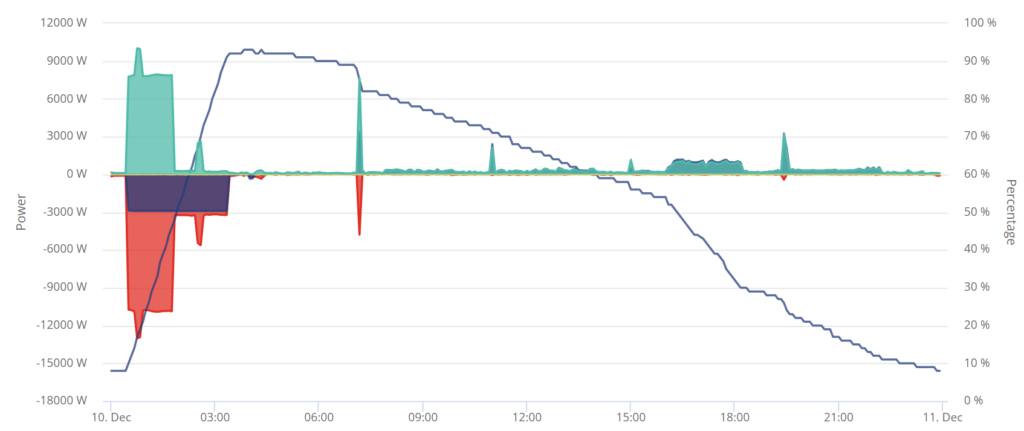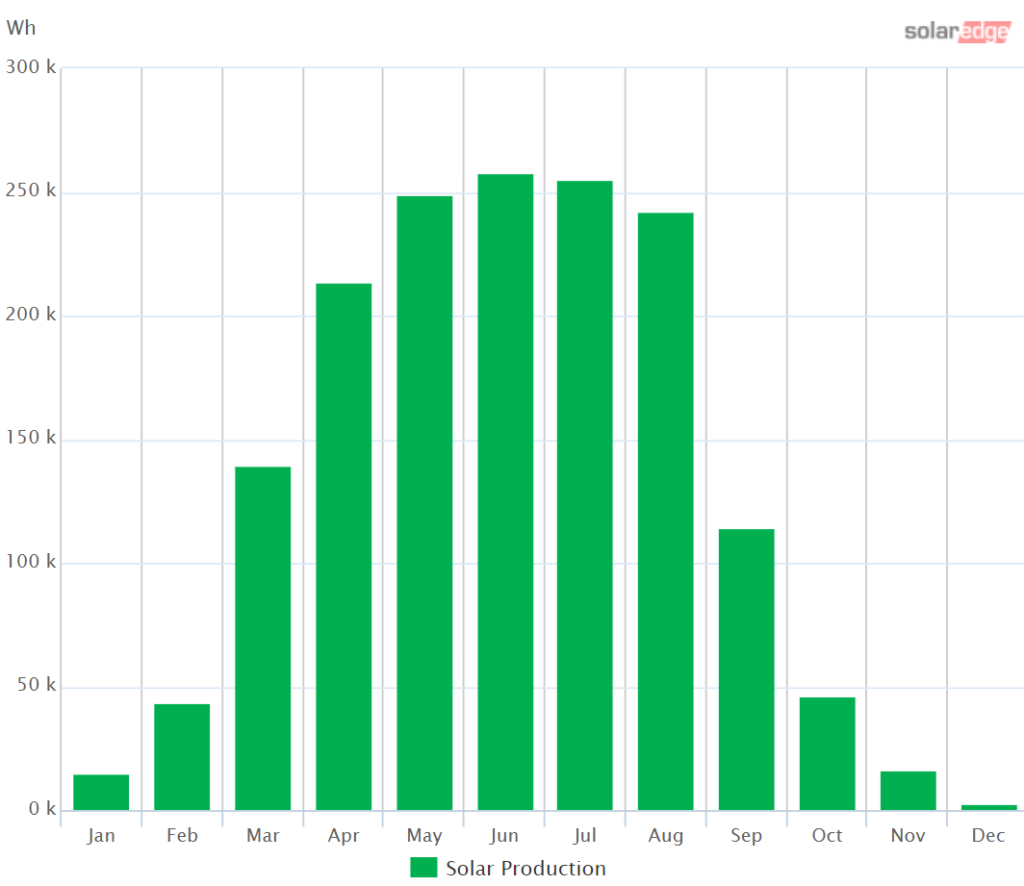Recently, we got a 9.5kwh givenergy battery fitted in our cellar. I was very excited about it, and keen to dive into the stats, and wrote a blog post about it here.
I’ve now had it for about a month and thought it was worth typing up the inevitable impressions having got used to the thing! So here goes…
First, some context. This is in a 2.5 bedroom (attic doesn’t count really) detached house, thats very old (pre napoleonic), but has been insulated to the best of our ability. 2 people working from home, in the southwest UK. Also be aware that this was during November/December, and a pretty cold December. As I type this, there is snow everywhere…
I had some initial confusion when the battery was first set up. Day 1, they calibrate it, by basically filling it with grid energy and then discharging it, which feels horrible when you see the first thing your battery does is suck up some prime-time expensive power! Luckily this is a one off thing :D. Once that first day is out of the way, you can then choose your settings and.. to be honest then completely forget about it! My settings, because I have cheap power (75% off!) from 12.30am – 4,30am, is for the battery to fill to 96% during that time and then be in ‘eco mode’ for the rest of each day.
GivEnergy’s eco mode is basically a maximise self-consumption, minimize grid import system. So if you have solar panels, and are producing more power than you are using (fat chance for here in December), the excess gets diverted into the battery. Any power load during the day gets sourced from the battery, so you see the battery state of charge slowly trickle down through the day as its used to power the house:

On the far left is the battery filling up (purple below the line) and my car charging. Combined, the battery charge and car charger hit 9,000w! You will see a few spikes during the day which are basically kettles and coffee machines, and cooking. It looks like breakfast was a big spike load on the grid! and then later mini spikes (below 3,000w) are handled entirely by the battery, slowly draining down to about 8% by midnight. That sustained power draw from 4pm-6pm is a gaming PC and huge monitor playing battlefield V :D.
The thing is… once you have watched these charts a few times, you kind of get the hang of it, and then never really need to look at them, or go near the battery ever again. Its just a magic box somewhere in your house that cuts your energy bill by 75%. The only tweak I have made is that now its even colder, and we are cooking more and for longer, I’ve adjusted it to fill to 96% instead of my original 90%, because we need a bit more energy each day (and if I can possibly avoid any prime-time energy consumption…I will!).
So this is all very well, but what have I learned that might be relevant for people who are considering installing a battery?
Firstly, you really need to get the size of the battery right. I kind of lucked-out a bit, and ended up with the perfect size, but nearly didn’t. At one point, we were going to get an 8.2kwh battery, then a 9.5kwh, then maybe 2x 9.5kwh ones, and even had a board installed on the cellar wall to support a 2nd one, but we ended up with a single 9.5kwh which feels right. Obviously, when you think about it, all you need to do is check your energy bill for how many kwh you use on average each day… and thats the size of the battery you want!

Its a bit more complex if you have solar, because if you have a decent solar array, there may be days where you are generating more than your daily usage, and want to store some in case its cloudy/raining the next day, to maximise your usage. Remember, the goal is to NEVER export any energy to the grid, because they pay you a pittance. So there are circumstances where you might need to oversize things…
For example, if your daily usage is 10kwh, but your solar array in June/July regularly produces 20kwh, then you will be using 10kwh, and sticking 10kwh in the battery for tomorrow. If you dips in solar power are fairly sparse, you will be often faced with surplus solar power and a full battery. IF you have an electric car too, and are bothered enough to trickle-charge it with the excess, then you can of course do this. There are setups and systems that can automate this BTW, that involve cables running to the EV charger from your battery/inverter, but I found it to be prohibitively complex, especially with our EV charger about 100ft from the fuse box.
I reckon for the vast majority of people, whether you have solar or not, you probably should stick to a simple format of just buying a battery that can hold 100-150% of your average daily usage. Its not like you can precisely pick a size anyway, as our options were basically 8.2kwh or 9.5kwh or some multiple.
Something that IS worth paying attention to is the inverter. You need an inverter coupled with your battery, or batteries. Its the thing that converts the stored power (DC) back to AC so the house appliances can use it. We have a first generation GivEnergy inverter, that runs at 3kw, and the ones run at 5kw. If at all possible get the higher output one. Get the highest output inverter you can. Why is this?
Its important to understand the difference between kw (kilowatts, thousands of watts) and kwh (kilowatt hours). The first is a measurement of power as in, the amount of oomph that is running down a cable to a thing, and the second is a measurement of stored energy, ie: the amount of oomph multiplied by how many hours you can provide it, before you run out. Or think of kw as your salary and kwh as your savings :D,
In my case, we have a 9.5kwh battery, fed by a 3kwh inverter. That means that even if the battery is FULL, if I plug in some theoretical device that wants to draw power at 9,000 watts… the battery can only squeeze out 3,000. The rest will get imported from the grid. Why does this matter? It matters because British homes have kettles! and also sometimes electric heaters! In an ideal world your day to day current draw will never exceed the power of your inverter. Every time it does, you will draw the excess from the grid.
With something like charging an EV, you need to just admit defeat. Most EV chargers at home are about 7kw, and you are not going to power your home AND an EV charger with a simple domestic battery and inverter. You need to schedule any EV charging for off peak anyway. The real culprits for going over 3kw are stuff like a kettle, a power-shower, or multiple induction hobs going at once. You might think 3,000 watts is a lot, but boil the kettle and fry some bacon while someone is in the shower and you zip right over that, no problem.
So… I’d suggest a 5kw or better inverter, and probably a 9.5kwh battery, or if you use slightly more energy than me, maybe a 13.5kwh Tesla powerwall. If you have a 4 bedroom house and power-hungry kids, and can afford it, maybe you have a good case for getting 2 9.5kwh givenergy’s or 2 powerwalls, especially if you also have solar.
So there ya go. I’m a total home-battery geek, and look at my stats every day, but if you arent that into it, but just want cheap electricity, then you can just go for it, set it up once, and then never look at it again! Ours is in the cellar and I only even see it if I go down to the cellar to get something out of the freezer :D. Batteries come with apps that will soon ping you if there is an error, so you can comfortably just ignore them.
I worked out on the basis of our first month that payback time for us was 5.7 years. That will fall a LOT in march when our fixed price tariff comes to an end, and fall AGAIN in summer when we get the advantage of saving up our surplus solar power during the day. (At the moment the only financial benefit for us is to buy cheap power overnight and use it during the day). I think in the long run the payback time for us will be maybe 3-3.5 years. Thats crazy good.
PLUS! We did it as a retrofit to existing solar. Right now the govt charges zero VAT on new solar, and batteries can be included, so if you can get solar+battery right now, its an even better deal. I highly recommend it!